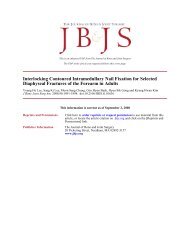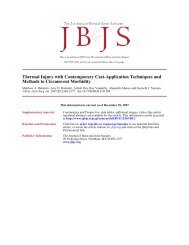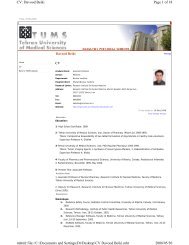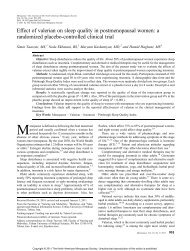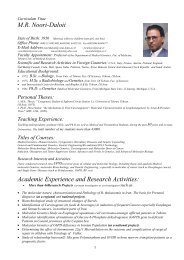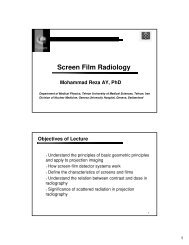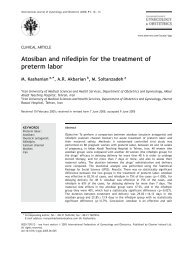Contrastive Analysis
Contrastive Analysis
Contrastive Analysis
Create successful ePaper yourself
Turn your PDF publications into a flip-book with our unique Google optimized e-Paper software.
<strong>Contrastive</strong> <strong>Analysis</strong><br />
<strong>Contrastive</strong> <strong>Analysis</strong><br />
And<br />
Error <strong>Analysis</strong><br />
By Nasrin Abdi<br />
Language Department
<strong>Contrastive</strong> <strong>Analysis</strong><br />
Introduction: Definition:<br />
<strong>Contrastive</strong> <strong>Analysis</strong> means the comparison of two languages by paying attention to differences and<br />
similarities between languages being compared.<br />
• It was first suggested by Whorf (1941) as contrastive linguistics , a comparative study<br />
which emphasizes on linguistic differences.<br />
• The publication of Robert Lados' book( linguistics across cultures) in 1957 was the start<br />
of modern applied contrastive linguistics. In later studies the term contrastive linguistics<br />
changed to contrastive analysis.<br />
The branches which contrastive analysis is involved:<br />
Translation- teaching- linguistics- textbook writing- error analysis<br />
1. Translation:<br />
a-As a translator should be faithful to the text so s/he should know the exact equivalents in two<br />
languages (source and target).<br />
b- A translator understands that most of the differences in two languages are not semantically but<br />
culturally.<br />
c- She/He understands that most of these different beliefs<br />
differences comes from different values<br />
different patterns of thought
2. Teaching:<br />
<strong>Contrastive</strong> <strong>Analysis</strong><br />
Learning the second language is different from acquiring the first language.<br />
A child acquiring English as a native language makes perceptual differences about different<br />
languages, he acquires language system.<br />
But a Persian child who is learning English as his / her second language does not have this perception<br />
about different situations, he / she just learns the language.<br />
e.g.: the concept of the word "cousin" for an English child is completely different from that of a<br />
Persian child.<br />
<strong>Contrastive</strong> analysis can help teachers to :<br />
- design teaching and learning materials (methodology)<br />
- engage learner in activities to be a good user of target language.(classroom activities)<br />
- evaluate text books.<br />
- pay attention to the structure of the texts beyond sentence level<br />
- pay attention to conversation in its regular pattern in different situations<br />
- pay attention to complex areas like intonation<br />
- pay attention to different underlying rules which differ from culture to culture<br />
- contrastive analysis does not suggest a method or teaching technique but help methodologists<br />
to pay attention to the whats of teaching and hows of teaching.
<strong>Contrastive</strong> <strong>Analysis</strong><br />
3. Linguistics<br />
o <strong>Contrastive</strong> analysis pays attention to different languages at lexical, phonological, syntactical<br />
and semantic levels<br />
o <strong>Contrastive</strong> studies find similarities and differences between languages in:<br />
a) Grammatical structures( pronouns, articles, verbs, consonants and vowels)<br />
b)Sentences and constructions ( interrogatives, relatives, negatives , normal phrases, syllables,<br />
diphthongs,…)<br />
c)Rules of the compared languages ( interrogative ,passivization and etc.)<br />
According to Richards (1971), researches show that contrastive analysis may be most predictive at<br />
the level of phonology and least predictive at the syntactic level, for this many of the common<br />
mistakes are syntactic errors in written work.<br />
4. Principle programming for writing a textbook.<br />
<strong>Contrastive</strong> analysis helps a textbook writer avoid using the material with a high degree of difficulty<br />
and high degree of occurrence in a same text ( which makes the text more difficult ) The writer<br />
should balance among the most difficult items and the least difficult items throughout the text.<br />
5. error analysis :<br />
<strong>Contrastive</strong> analysis helps you to classify the errors, predict and finally avoid them.(error analysis)
Interference theory:<br />
<strong>Contrastive</strong> <strong>Analysis</strong><br />
One of the important factors in studying contrastive analysis is paying attention to the definition of<br />
"interference Theory".<br />
Base on Psycholinguistics:<br />
You look at the second language through filter /glasses of the first language.<br />
The rules of the first language are matched with the rules of the second language.<br />
(You see that the rule systems of the source and target languages are different and sometimes<br />
the rules of languages are interfered with each other). So studying contrastive analysis can help<br />
you to understand and know these interferences.<br />
If certain elements of a second language differed greatly from the student’s native language,<br />
that student would likely encounter difficulties. (Lado 1957) it means sometimes your mother<br />
tongue interferes<br />
*Mary is interested to reading books.<br />
• Mary is interested in reading books.<br />
( ﻪﺑ ندﻮﺑﺪﻨﻣ ﻪﻗﻼﻋ)<br />
. ﺖﺳا ﺪﻨﻣ ﻪﻗﻼﻋ نﺪﻧاﻮﺧ بﺎﺘﮐ ﻪﺑ ﻢﻳﺮﻣ : لﺎﺜﻣ
<strong>Contrastive</strong> <strong>Analysis</strong><br />
Before discussing about the different hypothesis of contrastive analysis we should be familiar with the<br />
concept of difficulty and simplicity in language study, so we look at the hierarchy( degrees of<br />
difficulty) in languages:<br />
Degrees of difficulty<br />
A contrastive analyst should predict the level of difficulties in foreign language to avoid using high<br />
degree of difficulties along with a high degree of occurrences in a same text. Now we study the<br />
different levels of difficulties:<br />
1. Level 0: transfer<br />
1) No difference or contrast is present between the two languages. (Similar sounds, lexical items or<br />
similar structures in two languages are seen ( positive transfer))<br />
2) The learner can simply transfer (positively) a sound, a structure or lexical item form the native<br />
language to the target language.<br />
3) Concepts of negation and interrogation in two languages are the same.<br />
4) Word order in two languages has the same pattern.<br />
5) Such transfer makes no difficulty; hence the label of "level zero" is given to it.<br />
: لﺎﺜﻣ<br />
door=<br />
رد<br />
the wall=<br />
راﻮﻳد<br />
no=<br />
ﻪﻧ<br />
flower garden=<br />
ﻞﮔ ﻪﭽﻏﺎﺑ<br />
garden flower=<br />
ﻪﭽﻏﺎﺑ ﻞﮔ
<strong>Contrastive</strong> <strong>Analysis</strong><br />
2. level 1 : Coalescence :<br />
two or more items in the native language become coalesced (come together)into one item in the<br />
target language.( here our source language is Persian and target is English)<br />
زﻮﻣﺁ ﺶﻧاد<br />
ﻮﺠﺸﻧاد<br />
ﺎﻤﺵ you دﺮﮔﺎﺵ student<br />
ﻮﺕ ﻞﺼﺤﻣ<br />
native L. target L.<br />
Level 2: Underdifferentiation:<br />
An item in the native language is absent in the target language.<br />
( ﯽﻬﺕ ) ﯽﺴﻴﻠﮕﻧا رد = ( ﯽﺳرﺎﻓ رد)<br />
ﺮﮕﻣ / ﻦﻴﻣﺪﻨچ<br />
(. ﺪﻨﮑﻴﻣ زوﺮﺑ ﺮﮕﻳد ﯽﺘﻴﻔﻴﮐ ﺎﺑ ﺎﻳ ﯽﻬﺕ ) ﯽﺴﻴﻠﮕﻧا رد = ( ﯽﺳرﺎﻓ رد)<br />
[x] ﯼاﺪﺹ<br />
Level 3: Reinterpretation:<br />
- An item that exists in the native language (Persian) is given a new shape or distribution. It is<br />
similar to a given item in the target language (English) but not the same.<br />
- A Persian learner overgeneralizes on the basis of similarities and make errors<br />
Present perfect in Persian language = present perfect in English language<br />
=present progressive in English language<br />
. ( ﯽﺴﻴﻠﮕﻧا رد ﻞﻣﺎﮐ لﺎﺡ)<br />
we have read this book=<br />
( ﯽﺳرﺎﻓ رد ﻞﻣﺎﮐ لﺎﺡ ) ﻢﻳا ﻩﺪﻧاﻮﺧ<br />
ار بﺎﺘﮐ ﻦﻳا ﺎﻣ<br />
( ﯽﺴﻴﻠﮕﻧا رد ﻞﻣﺎﮐ لﺎﺡ)<br />
we haven’t had supper yet. =( ﯽﺳرﺎﻓ رد ﻞﻣﺎﮐ لﺎﺡ)<br />
ﻢﻳا ﻩدرﻮﺨﻧ مﺎﺵ زﻮﻨه ﺎﻣ<br />
( ﯽﺴﻴﻠﮕﻧا رد ﯼراﺮﻤﺘﺳا لﺎﺡ)<br />
we are sitting in the classroom. =.( ﯽﺳرﺎﻓ رد ﻞﻣﺎﮐ لﺎﺡ)<br />
ﻢﻳا ﻪﺘﺴﺸﻧ سﻼﮐ رد ﺎﻣ<br />
Level 4: over differentiation :<br />
A new item in target language (English) which is absent in language (Persian).<br />
Initial consonants cluster like (school –student)<br />
Present perfect continuous( have been + ing )in English =? In Persian<br />
Future in the past(would + infinitive without to) in English= ? in Persian<br />
Past perfect continuous(had been + ing) in English = ? in Persian<br />
[ð] and [θ] in English = ? in Persian
<strong>Contrastive</strong> <strong>Analysis</strong><br />
Level 5: split an item in the native language (Persian) refers to more than one references in<br />
target language ( English)<br />
ﺰﻴﻣ table . موﺮﻴﻣ ﻪﺳرﺪﻣ<br />
I go to school ﺲﻴﺋر president- director-<br />
Desk I'm going to school boss- chief- chairman-<br />
I'll go to school. chancellor- dean-master<br />
گرﺰﺑ big(mistake)<br />
Great(man)<br />
Large(house)<br />
Grown up (boy)<br />
Major (problem)
<strong>Contrastive</strong> analysis Hypotheses (CAH):<br />
<strong>Contrastive</strong> <strong>Analysis</strong><br />
I. Strong Version:<br />
According to some of behavioristic psychologists the principle of transfer is at work in learning. (<br />
transfer: affecting the first language on the second one)<br />
Positive transfer<br />
Transfer<br />
Negative transfer<br />
Positive transfer: 1) It occurs when the first language is similar to the second language.<br />
2) The learner has no difficulty in learning language( because what he has<br />
learned in the first language is positively transferred into the second one.<br />
3. In positive transfer first language helps learning the second language<br />
Negative transfer: 1) It is problematic, because of interference of the first language on the<br />
second one. (It occurs when the first language is different from the second<br />
language.)<br />
2) Learning differences in language takes a lot of time an energy<br />
3) The first learning inhibits (prevents ) the second learning.
Conclusion: strong version<br />
<strong>Contrastive</strong> <strong>Analysis</strong><br />
Learning similarities is easy<br />
Learning differences is difficult and makes interference.<br />
Weak point of this theory: This theory can only describe interlingual errors. Errors in foreign<br />
language which are caused by interferences.( just one third of errors are predicted)<br />
II. Weak Version: 1)This hypothesis believes that the principle of transfer is just valid for<br />
animal learning not human learning.<br />
2) In the learning of a second language, the native language of the student does<br />
not really" interfere" with his learning, but it plays as an " escape hatch" when<br />
the learner gets into trouble.<br />
3This view point suggests that what will be most difficult for the learner is his<br />
lack of knowledge in the target language and his native language helps him in<br />
this regard.<br />
For example:<br />
Producing the interdental fricatives [ ð and θ] for a Persian learner of English is difficult not because<br />
of inhabitation or transfer of first language into second ,but it is because his lack of knowledge about<br />
these sounds in English. [s, t, z,d] he uses these sounds instead because he has not yet learned how<br />
to produce these English sounds
<strong>Contrastive</strong> <strong>Analysis</strong><br />
III. Moderate Version :<br />
• This hypothesis believes in the affect of principle of stimulus generalization in the learning of a<br />
native or foreign language.<br />
• this theory pays attention to the learner’s errors and tries to predict it.<br />
This theory says that : more difference between two languages, more easily to learn and<br />
internalize it. (Similarities make confusion to learn language.)<br />
• This theory can predict and categorize a large number of errors in language resulting of<br />
overgeneralization of rules either in native or target language.
<strong>Contrastive</strong> <strong>Analysis</strong><br />
How to compare languages:<br />
1- choosing a special theoretical model.( traditional, structural or transformational)<br />
2- then structures are compared and contrasted<br />
Five steps for systematic comparison and contrast of two languages:<br />
Selection- description- comparison- prediction-verification<br />
1) selection:<br />
it is impossible to compare every sound , word , structure and etc.of two languages, so the<br />
analyst should be limited.<br />
He/she can do the selection through:<br />
- personal experience<br />
- bilingual intuition<br />
- error analysis<br />
In this step you should decide what is to be compared with what .<br />
two elements to be compared in two languages should be similar in some extent.<br />
2) description:<br />
1-The selected materials will be linguistically described.<br />
2- two languages should be described within the same theory.<br />
3- for describing the sound systems of two languages we use structural phonology.<br />
4- for studying and describing syntax and morphology, there is no specific theory.<br />
5-The focus is on differences not similarities
3) Comparison:<br />
<strong>Contrastive</strong> <strong>Analysis</strong><br />
1-The similarities and differences are compared in three levels :<br />
- form<br />
- meaning<br />
- distribution of items in 2 languages which have been collected<br />
2- no comparison is possible without a full description<br />
3- the basic elements and structures should be compared with each other<br />
4) prediction:<br />
1-Now the contrastive analyst can predict for the differences and similarities of two languages.<br />
2-He / she should judge whether these similarities and differences are problematic or not (deviant<br />
structures and interference structures are predicted.)<br />
3- sometimes deviants reflect the structures of mother tongue.<br />
5) Verification:<br />
1- It is the final step in a contrastive study.<br />
2-To find out if the predictions made in the forth step (prediction) is true in reality or not.( Do<br />
Persian learners of English, in reality commit the errors which the contrastive analyst predict it or<br />
not?)
<strong>Contrastive</strong> <strong>Analysis</strong><br />
How to compare two syntactic /grammatical structures?<br />
grammatical signals in languages which a contrastive analyst should pay attention in his/her<br />
comparing and contrasting languages are :<br />
1-First grammatical signal :WORD ORDER:<br />
. دراد<br />
ﻪﭽﻏﺎﺑ<br />
ﻞﮔ<br />
ﮏﻳ نﺎﺝ -----John<br />
has a garden<br />
modifier head modifier head<br />
flower.<br />
( it refers to a flower)<br />
دراد ﻞﮔ ﻪﭽﻏﺎﺑ ﮏﻳ نﺎﺝ ------John has a flower garden.(it refers to a garden).<br />
modifier - Head modifier head<br />
ﻩﻮﻴﻣ غﺎﺑ -غﺎﺑ<br />
ﻩﻮﻴﻣ<br />
comparing and contrasting two languages:<br />
1- Differences of two languages:<br />
-"Head word" in English is the second word in a compound but in Persian "head word" is the first<br />
word.<br />
. ﺖﺳا ﻦﻣ<br />
ﯽﺒﻴﺝ<br />
ﺖﻋﺎﺳ ﻦﻳا<br />
This is my Pocket<br />
watch .<br />
Modifier - head Modifier head<br />
.ﺖﺳا ﻦﻣ ﺖﻋﺎﺳ ﺐﻴﺝ ﻦﻳا This is my watch pocket<br />
Modifier head<br />
2- Similarity of two languages:<br />
modifier head<br />
Different word orders in two languages make different meanings with a different grammatical rule of<br />
"Genitive Case"<br />
Two different word order two different meanings
<strong>Contrastive</strong> <strong>Analysis</strong><br />
2-second grammatical signal :INFLECTION:<br />
similarities of Inflection in two languages:<br />
inflections show:<br />
o plural morpheme : pen -pens / ﺎه ﻢﻠﻗ -ﻢﻠﻗ<br />
o gender :actor, actress/ نز ﺮﮕﻳزﺎﺑ -دﺮﻣ<br />
ﺮﮕﻳزﺎﺑ<br />
o tense: play, played/ ﻢﻳدﺮﮐ ﯼزﺎﺑ -ﻢﻴﻨﮐ<br />
ﯼرﺎﺑ<br />
o genitive case: Mary’s book/ ﻢﻳﺮﻣ بﺎﺘﮐ<br />
o comparison: large, larger, largest/ ﻦﻳﺮﺘﮔرﺰﺑ -ﺮﺘﮔرﺰﺑ<br />
-گرﺰﺑ<br />
differences of Inflection in two languages:<br />
1) plural morpheme in English: - s/ -es / z in English(phonological rules:[s]/[ez]/[z]<br />
cats/ houses/dogs<br />
plural morpheme in Persian: نا / ﺎه<br />
in Persian(animate and inanimate)<br />
( ﺎه ﯽﻝﺪﻨﺹ -ﺎهﺮﺘﺧد)<br />
ﺎه<br />
( ناﺮﺘﺧد)<br />
نا<br />
2)Gender: no sign in Persian , in English we have it just in few words:<br />
Like waiter/ waitress – prince/princess- actor/ actress<br />
3)Tense markers/ inflections in English are very limited:<br />
Simple present tense= -s/ es<br />
Simple past tense= -d / -ed<br />
( ﺪﻧا-ﺪﻳا–<br />
ﻢﻳا -ﺪﻳا–<br />
ﯼا-ما)<br />
ﻪﺳﺎﻨﺵ + عرﺎﻀﻣ ﻦﺑ + ﯽﻣ = ﯼرﺎﺒﺧا عرﺎﻀﻣ<br />
ﻪﺳﺎﻨﺵ + عرﺎﻀﻣ ﻦﺑ + ب = ﯽﻣاﺰﺘﻝا عرﺎﻀﻣ<br />
ﻪﺳﺎﻨﺵ + ﯽﺽﺎﻣ ﻦﺑ = ﻩدﺎﺳ ﯽﺽﺎﻣ<br />
ﻪﺳﺎﻨﺵ + ﯽﺽﺎﻣ ﻦﺑ + ﯽﻣ = ﯼراﺮﻤﺘﺳا ﯽﺽﺎﻣ<br />
ﻪﺳﺎﻨﺵ + ﯽﻝﻮﻌﻔﻣ ﺖﻘﺹ = ﯽﻠﻘﻧ ﯽﺽﺎﻣ<br />
4)Genitive case in English is ‘s and of but in Persian there is no inflection for genitive except ﻪﻓﺎﺽا ﻩﺮﺴﮐ<br />
5)Comparative and superlative adjectives in English: for one or two syllables= -er and –est are<br />
used and for more than two syllables :more and the most are used<br />
But there is no any rule in Persian about the number of syllables
<strong>Contrastive</strong> <strong>Analysis</strong><br />
3-third grammatical signal :CORRELATION OF FORM:<br />
The list of the books which is on the table……..( the list is on the table)<br />
The list of the books which are on the table …….(the books are on the table)<br />
The list of the men who are in the hall….(the men are in the hall)<br />
(ﺖﺳا ﺰﻴﻣ ﯼور ﺖﺴﻴﻝ)..........ﺖﺳا ﺰﻴﻣ ﯼور ﻪﮐ ﺎﻬﺑﺎﺘﮐ ﺖﺴﻴﻝ<br />
(ﺖﺳاﺰﻴﻣ ﯼور ﺎﻬﺑﺎﺘﮐ )......ﺪﻧا /.ﺖﺳا ﺰﻴﻣ ﯼور ﻪﮐ ﯽﺋﺎﻬﺑﺎﺘﮐ ﺖﺴﻴﻝ<br />
(ﺪﻨﺘﺴه ﻦﻝﺎﺳ رد نادﺮﻣ)......ﺪﻨﺘﺴه ﻦﻝﺎﺳ رد ﻪﮐ ﯽﻧادﺮﻣ ﺖﺴﻴﻝ<br />
---------------------------------------------------------------------------------------------------<br />
Comparision:<br />
In English there is a correlation / agreement between plural and singular subject and verb,<br />
In Persian a plural inanimate subject can be used with a plural or singular verb<br />
-------------------------------------------------------------------------------------------------------------<br />
Mary has many books. .دراد ﯼدﺎﻳز ﯼﺎﻬﺑﺎﺘﮐ ﻢﻳﺮﻣ<br />
Mary has two books (ﺎه بﺎﺘﮐ ود ﻪﻧ)دراد بﺎﺘﮐ ود ﻢﻳﺮﻣ<br />
A Persian learner makes errors in these cases.<br />
-----------------------------------------------------------------------------------------------------<br />
This is one of the best books that have ever been written.<br />
This is the only one of our books that has been written by an African author.<br />
4- Fourth grammatical signal: FUNCTION WORDS :<br />
Mary came. . ﺪﻣﺁ ﻢﻳﺮﻣ<br />
She came.<br />
The girl came.<br />
Who came? ؟ﺪﻣﺁ ﯽﮐ
<strong>Contrastive</strong> <strong>Analysis</strong><br />
5- fifth grammatical signal : INTONATION:<br />
3<br />
Mary is a student .<br />
ﺖﺳ ﻮﺠﺸﻧاد ﻢﻳﺮﻣ<br />
2 1 No difference<br />
3 3<br />
Mary is a student? ؟ﺖﺳﻮﺠﺸﻧاد ﻢﻳﺮﻣ<br />
2<br />
3 When did John arrive? ؟ﺪﻴﺳر ﯽﮐ نﺎﺝ(rising –falling)<br />
2<br />
(rising –falling)<br />
؟ﺪﻴﺳر ﯽﮐ نﺎﺝ(falling-rising)<br />
6- sixth grammatical signal: STRESS :<br />
It is the rising of pitch on a syllable in a word.<br />
Function words: prepositions, pronouns, conjunctions ( no stress)<br />
Nouns, verbs, adjectives, and adverbs ( take stress)<br />
1. When did Mary go to college?<br />
2. Mary went to college ‘yesterday.<br />
3. Where did Mary go yesterday?<br />
4. Mary went to college ‘yesterday.<br />
5. Who went to college yesterday?<br />
6. ‘Mary went to college yesterday.<br />
7. . ﺪﻧرادﺮﺑ ﺪﻧرادﺮﺑ ﻪﮐ نﺎﻧﺁداﺮﻣ زا رﻮﺼﻨﻣ ﻮچ<br />
7- Seventh grammatical signal :PAUSE:<br />
The length of silence between words or group of words.(in writing it is shown by comma.)<br />
. ﺎﻴﺑ ادﺮﻓ ﺲﭘ ﯽﻳﺁ ﯽﻤﻧ زوﺮﻣا ﺮﮔا<br />
. ﺪﻴﻨﮐ ﺶﻣاﺪﻋا ﺖﺴﻴﻧ مزﻻ ﺶﺸﺨﺑ<br />
*****************************************
<strong>Contrastive</strong> <strong>Analysis</strong><br />
- <strong>Contrastive</strong> analysis at Lexical level of two languages:<br />
Studying the lexical relationship among the languages through contrastive analysis helps the<br />
learner or translator to choose the best vocabulary he needs in order to convey the meaning.<br />
<strong>Contrastive</strong> analysis looks at the formal, semantic and pragmatic properties of the word in two<br />
languages.<br />
Patterns of similarities and differences which cause problems in vocabulary or translation of a text:<br />
1- Cognate= false cognate<br />
2- words similar in meaning but different in form<br />
3- words with strange meaning<br />
4- idioms<br />
5- words that have different connotations in the two languages<br />
6- geographically- restricted words<br />
1- cognates= False or deceptive cognates; ﻩداﻮﻧﺎﺧ ﻢه نﺎﮔژاو<br />
these words have similar pronunciation and meaning in two languages:<br />
door=رد<br />
the wall=راﻮﻳد<br />
Use of Excusez moi instead of pardon by a native English speaker who is learning French.<br />
Using “commence” instead of “start or begin” in oral conversation.<br />
( ﺖﺳﺎﻄﺧ).<br />
ﺖﺵﺬﮔرد ﯼا ﻪﺙدﺎﺡ رد ﻪﺘﺵﺬﮔ ﺐﺵ مرﺪﭘ ﺖﺳود : ﯼا ﻩروﺎﺤﻣ ﯽﺳرﺎﻓ رد<br />
Class= سﻼﮐ<br />
Professor=رﻮﺴﻓوﺮﭘ<br />
According to discourse, cognates are the easiest types of words and their learning is so easy.<br />
The difficulty of this type of word is the frequency of the use of word and the restriction imposed<br />
on it.
<strong>Contrastive</strong> <strong>Analysis</strong><br />
2-Words similar in meaning but different in form:<br />
The degree of difficulty for learning these words is normal.<br />
Friend= ﺖﺳود<br />
Although the meaning of these words is similar but the exact cultural aspects of languages towards<br />
this word may be different in two languages.<br />
3-Words with strange meanings:<br />
The degree of difficulty here is high and it makes a lot of misunderstanding in two languages.<br />
لوا ﻪﻘﺒﻃ=second floor( in American English)<br />
ﻒﮑﻤه ﻪﻘﺒﻃ=first floor<br />
cousin<br />
ﻪﻝﺎﺧﺮﺴﭘ<br />
ﯽﺋادﺮﺴﭘ<br />
ﻪﻝﺎﺧﺮﺘﺧد<br />
ﻮﻤﻋﺮﺘﺧد<br />
(Coalescence/ convergence)<br />
Two or more items in the native language become coalesced (come together)into one item in the<br />
target language. here our source language is Persian and target is English)<br />
(split/ divergence) an item in the native language (Persian) refers to more than one references in<br />
target language ( English)<br />
big(mistake)<br />
Great(man)<br />
Large(house) گرﺰﺑ<br />
Grown up (boy)<br />
Major(problem)<br />
Serious نﺎﺑز language<br />
Hard tongue نﺎﺑز<br />
do you know English tongue?(error)<br />
I have a hard disease( instead of serious).(error)<br />
ﻪﻤﻋﺮﺴﭘ
<strong>Contrastive</strong> <strong>Analysis</strong><br />
4-Idioms:<br />
Idioms are phrasal verbs or metaphoric expressions.<br />
Dull knife=ﺪﻨﮐ ﯼﻮﻗﺎچ call= ندﺮﮐ ﻦﻔﻠﺕ / ندز اﺪﺹ<br />
Dull color=رﺎﺕ ﮓﻧر call up=نﺪﻧز ﻦﻔﻠﺕ<br />
Dull pain=ﻢﻬﺒﻣ درد<br />
Dull book=ﻩﺪﻨﻨﮐ ﻪﺘﺴﺧ بﺎﺘﮐ<br />
He’s dull= ندﻮﮐ م دﺁ<br />
call on=ندز ﺮﺳ<br />
5-Words with different connotations:<br />
Sometimes using words in translation should meet the cultural favorites of target language, it<br />
means that some words may be neutral meaning in our native language but they bear some<br />
offensive or immoral connotation in target language.<br />
Pub using this word in a text should be very careful.<br />
6-Geographically- restricted words<br />
Some words or expressions use differently in different dialects<br />
Petrol(in Britain)=gasoline(in America)<br />
Lift( in Britain)= elevator ( in America)
<strong>Contrastive</strong> <strong>Analysis</strong><br />
Different kinds of contrastive analysis:<br />
According to different views toward communication we have two approaches of contrastive<br />
analysis:<br />
1- classical contrastive analysis:<br />
a) Language is a self-contained system<br />
b) It believes in Code linguistics.<br />
Code linguistics deals with language as an abstract system , using grammatical<br />
competence to distinguish syntax, semantics, phonology and lexicon.<br />
d) It is a linguistically- oriented approach<br />
e) It is static<br />
f) The focus is on linguistic elements so the teaching materials focused on presenting and<br />
practicing the linguistic materials which differ in two languages.<br />
2- Modern <strong>Contrastive</strong> analysis:<br />
a) Language is a means of communication<br />
b) It believes in Human linguistics.<br />
Human linguistics deals with language as a concrete system, using communicative<br />
competence to describe the process of human communication. It falls within the domain<br />
of pragmatics (holistic interpretation of language).<br />
c) it is a communicatively- oriented approach or participant- oriented approach.<br />
d)It is a dynamic approach.<br />
e) the focus is on the process of development of discourse as the basis for communication.<br />
F) the discourse analyst studies the relationship between language and the context in which it is<br />
used.( it concerns with how people use real language)
<strong>Contrastive</strong> <strong>Analysis</strong><br />
Advantages of modern contrastive analysis:<br />
• Static approach unlike the Dynamic approach is insufficient in comparing and contrasting the<br />
languages because:<br />
• It can not predict all the errors in producing the language, and also it can not predict all the<br />
linguistic interferences in language because some of these interferences related to the process of<br />
communication. But Dynamic approach (modern approach) can predict the errors:<br />
Why don’t you call your mother?<br />
Request for information<br />
Suggestion<br />
.ﯼدز ﯽﻣ ﮓﻧز ﻦﻣ ﻪﺑ ﺪﻳﺎﺑ<br />
Threatening<br />
Suggestion /offer<br />
Order<br />
You are not going out….<br />
Prohibition ﺖﻌﻧﺎﻤﻣ ( ﯼراﺪﻧ زﺎﺝا)<br />
ﯼﺮﺑ نوﺮﻴﺑ ﺪﻳﺎﺒﻧ<br />
Confirmation( ﺪﻴﻳﺎﺕ ) ﯼر ﯽﻤﻧ نوﺮﻴﺑ ﻪﮐ ﻢﻧود ﯽﻣ<br />
Threatening( ﺪﻳﺪﻬﺕ)<br />
! ﯼر ﯽﻤﻧ نوﺮﻴﺑ ﺲﭘ<br />
Surprise( ﺐﺠﻌﺕ ) ﯼﺮﻴﻤﻧ نوﺮﻴﺑ<br />
ﺐﺠﻋ<br />
Stating ﺮﺒﺧ ( ﻩر ﯽﻣ ﯽﻠﻋ ) نوﺮﻴﺑ ﯼﺮﺑ ﺖﺴﻴﻧ مزﻻ ﻮﺕ<br />
Dynamic approach leads contrastive analysis towards pragmatics and discourse
<strong>Contrastive</strong> <strong>Analysis</strong><br />
Discourse <strong>Analysis</strong><br />
Studying language forms without paying attention to language use is incomplete, so contrastive<br />
analysis goes beyond the limitations of structure and analyzes the use of language in<br />
a socio cultural setting.<br />
So all the models of contrastive analysis which neglect the influence of extra-linguistic factors in<br />
speech are defective.<br />
There are some factors, beside linguistic rules which help the transmission of meaning between<br />
the two participants in a conversation:<br />
1- what the speaker thinks the listener knows.<br />
2- The listener attitudes/ behaviors in conversation<br />
3- Mutual agreement or disagreement between participants<br />
4- Shared knowledge<br />
5- Giving a number of verbal and non-verbal cues for mutual understanding
<strong>Contrastive</strong> <strong>Analysis</strong><br />
<strong>Contrastive</strong> analysis at Discourse level( discourse analysis):<br />
We have two kinds of language :spoken (conversation) and written(text)<br />
The difference between written discourse and spoken discourse:<br />
• Most of the time in conversation or spoken language it is impossible to decide the exact function<br />
of participants or their different feed backs in talking.<br />
• But in written language the writer unlike speaker has the time to think about what to write and<br />
how to write . for this reason the sentences are usually well-formed.<br />
It seems in any oral conversation there are three parts:<br />
• first, a question,<br />
• an answer and<br />
• a comment( feed back) which in some languages the feed back can have some “ follow-up” like<br />
e.g.:<br />
- what time is it? A- what time is it?<br />
- Five past six. B- five past six.<br />
- Thank you. A- good! Clever girl<br />
A – Do you think it’s the time for coming to class?<br />
Pragmatic aspects of language according to discourse analysis:<br />
For creating a dialogue we should have some basic elements: 5-Substitution:<br />
1-Presupposition 5-Conjunctions:<br />
2-Context 6-Propositions:<br />
3-Deictic expressions: ﯽﻝﻻﺪﺘﺳا ﯼﺎﻬﺕرﺎﺒﻋ 7-Speech acts( illocutionary act<br />
4-Ellipsis : 8-Cohesion: ( cohesive tie)<br />
9-Coherence
<strong>Contrastive</strong> <strong>Analysis</strong><br />
1-Presupposition:<br />
It means that the speaker and listener have some shared knowledge , presupposition is what<br />
speaker assumes to be true or to be known to the hearer.<br />
In contrastive studies a teacher should instruct the students in this area.<br />
For example:<br />
A: at last I bought it. . ﺪﻨﻨﮐ ﯽﻤﻧ ﮎرد ار ﻢه فﺮﺡﺪﻨﺵﺎﺑ<br />
ﻪﺘﺵاﺪﻧ ضﺮﻓ ﺶﻴﭘ ﻢه زا ﺮﮔا<br />
B: really! How nice to hear it. Is it large or small?<br />
A: not large, but very comfortable!<br />
B: is it expensive?<br />
A: you know all apartments are expensive!<br />
2-Context:<br />
linguistic context ( there are some clues in sentence to help us to understand the speaker).<br />
Physical context(there are some signs in environment or setting which can help you to understand<br />
the speaker)<br />
This is another aspect of language which is problematic and should be considered by contrastive<br />
analysis.<br />
e.g.:<br />
I went to the bank.( it is not linguistic context because we don't have any clues to understand which bank the speaker means)<br />
I went to the bank to cash my cheque.( It is linguistic context because the sentence has some signs to show the concept of the word<br />
bank)<br />
I saw a pupil in the hospital. ( it is not linguistic context)<br />
I saw a pupil in the hospital and talked to him.<br />
pupil= زﻮﻣﺁ ﺶﻧاد + ﻢﺸچ ﮏﻣدﺮﻣ<br />
In physical context the sign of bank is fit on the wall of a building, so we easily understand the word bank here is a financial<br />
institution.
<strong>Contrastive</strong> <strong>Analysis</strong><br />
3- Deictic expressions: ﯽﻝﻻﺪﺘﺳا ﯼﺎﻬﺕرﺎﺒﻋ<br />
Deictic expressions are the words which can never be interpreted unless the physical context<br />
(reference) of the speaker is known.<br />
Pronouns<br />
Possessive adjectives( My,..)<br />
Demonstratives(this, that..)<br />
Some adverbs( here, yesterday..)<br />
she went there with her mother.<br />
John met Marry in front of her home.<br />
They went to the movies together.<br />
4-Ellipsis :<br />
It is a voluntary grammatical omission in sentence. As ellipsis is a universal feature of language<br />
and these omissions occur in most of languages, the place of omission may be problematic .<br />
John will carry the large boxes, Mary the small boxes<br />
. ﻢﻨﮐ ﮏﻤﮐ ﯽﺸﮐ بﺎﺒﺳا ﯼﻮﺕ ﺖﻬﺑ ﻢﻧﻮﺕ ﯽﻣ مرﺎﮑﻴﺑ ادﺮﻓ ﻦﻣ -<br />
ﺖﺳا ﻩﺪﺵ فﺬﺡ (. ﻢﻨﮐ ﮏﻤﮐ ﺖﻬﺑ ﯽﺸﮐ بﺎﺒﺳا ﯼﻮﺕ ﻪﮐ ) ﻮﮕﺑ ﻢﻬﺑ ﯽﺘﺳاﻮﺧ ﻪﮔا -<br />
5-Substitution:<br />
Substitution is also a universal feature in grammar of all languages. And it is problematic for<br />
translation.<br />
John chose a novel; Mary chose the same.<br />
.مداد ﺲﭘ ور ﻪﻧﺎﺨﺑﺎﺘﮐ لﺎﻣ، مﺪﻳﺮﺧ نﺎﺑز بﺎﺘﮐ ﮏﻳ ﯽﺘﻗو
<strong>Contrastive</strong> <strong>Analysis</strong><br />
6-Conjunctions:<br />
Conjunctions are the signals between segments of the discourse. Discourse analysis tries to find<br />
the role of conjunctions in different languages.<br />
( Conjunctions like: and, but, although, consequently …)<br />
The bad feeling was a consequence of the teacher’s attitudes towards the students.<br />
7-Propositions:<br />
There is one thought in sentence, a central idea in a sentence which is called proposition.<br />
By producing a sentence we do two things:<br />
expressing a proposition<br />
Perform an illocutionary act( speech act)<br />
8-Speech acts( illocutionary act:<br />
direct speech acts request<br />
Indirect speech acts giving information<br />
Apologizing<br />
Order<br />
Showing surprise<br />
Threatening<br />
Speech acts deals with syntax and they show the functions of language.<br />
The class is not over.(Giving information)<br />
Come here.(Order/ request)<br />
What good students you are.(Showing surprise.)<br />
Can you pass the sugar? (Form: question and the function request)<br />
She said that her husband would return the parcel tomorrow<br />
.( giving information)<br />
. ﻢﺘﺴه ﯽﻧﺎﺒﺼﻋ تﺪﺵ ﻪﺑ زوﺮﻣا (Illocutionary act):<br />
( threatening)<br />
(threatening)<br />
(Proposition) : ( ندﻮﺑ ﯽﻧﺎﺒﺼﻋ)
<strong>Contrastive</strong> <strong>Analysis</strong><br />
9-Cohesion: ( cohesive tie)<br />
Cohesion is overt (observable) links and connections between the sentences and clauses in a text.<br />
Texts often contain signals which help a reader to interpret them and find the relations between<br />
segments.<br />
A: what did the police do.<br />
B: they arrested the demonstrators.ﻩﺪﻨﻨﮐ ﺮهﺎﻈﺕ<br />
B: the pigs arrested them.<br />
My father once bought a Lincoln convertible. He did it by saving every penny he could. That car was very expensive. He loved it ,<br />
however; he sold it to help pay for my college education. Sometimes I think I’d rather have the convertible!<br />
10-Coherence:<br />
Coherence is the covert relationship /link between the sentences (propositions) which can be<br />
interpreted through illocutionary act.<br />
Nancy: that’s the telephone!<br />
Bob: I’m in bath.<br />
Nancy: ok<br />
In these sentences there is no clear connection but we can find the links
<strong>Contrastive</strong> <strong>Analysis</strong><br />
Error <strong>Analysis</strong><br />
Because of shortcomings of the contrastive <strong>Analysis</strong> to clarifying the second-language errors,<br />
researchers began to look for another approach which was both theoretical and practical; this<br />
approach is called Error <strong>Analysis</strong>.<br />
The difference between errors and mistakes:<br />
1. Errors are rule-governed , they are systematic and show the lack of knowledge of learners.<br />
2. Mistakes are random deviations, unrelated to any system<br />
3. mistakes may occur in writing of native speaker, or during speech, such as slips of tongue,<br />
slips of pen, slips of the ear. Mistakes happen because of strong emotion, memory<br />
limitations, lack of concentration or tiredness.<br />
4. sometimes the distinguishing between mistakes and errors is difficult, but according to<br />
linguistics, mistakes have a rather low frequency but errors have high frequency and they are<br />
systematic.<br />
Errors can be described in three dimensions:<br />
1-Types of errors<br />
2-levels of errors<br />
3-Stages of errors
1-Types of errors;<br />
1- addition :<br />
1-*does can he go to college?<br />
2-*he will to go home.<br />
3-* he entered into the class room.<br />
4- *they always discuss about different matters.<br />
5- *Please answer to my letter soon<br />
6- *Good writing is depends on several factors<br />
7-*he was going to home when I saw him.<br />
2- Omission / deletion:<br />
1- *I went to movie.<br />
2- * My father is # doctor<br />
3- *I am learn # English well.<br />
4-* I bought three new book# yesterday.<br />
5-* what # you want to do now?<br />
3- Ordering / Reordering:<br />
1-* I to the cinema went.<br />
2- * We last night went to the cinema.<br />
3-* He comes always late to school.<br />
4- *My brother is a driver fast.<br />
5- * I don't know why is he late<br />
4- Substitution:<br />
1-*I lost my road.(way)<br />
2-*I goed home.(went)<br />
3-*I am not afraid from dogs.( of)<br />
4- *He was angry form his bad marks.(at)<br />
5- *His bigger brother is a teacher.(elder)<br />
6- *I always do many mistakes in spelling(make)<br />
<strong>Contrastive</strong> <strong>Analysis</strong>
2-Levels of errors:<br />
a- phonology (orthography)<br />
b-grammar(syntax)<br />
c- lexicon(vocabulary)<br />
d-discourse<br />
a- phonology/ orthography error :<br />
I went to school.<br />
*I went to skul.<br />
He is happier than Mary.<br />
* he is happyer than Mary.<br />
<strong>Contrastive</strong> <strong>Analysis</strong><br />
b- grammar/ syntax:<br />
He has been in London since 1960.<br />
*He was in London since 1960.( level: grammar-Type: substitution)<br />
* I to the cinema went.( level: grammar.- type: ordering)<br />
c- lexicon(vocabulary);<br />
*I lost my road.(level: lexicon- type: substitution)<br />
* I drank a glass of lion yesterday.(level: lexicon- type: substitution)<br />
* I enjoyed from the film.( level: lexicon- type: addition)<br />
d- discourse: it is beyond sentence level.<br />
A: How are you?<br />
B: the crops were destroyed by the rain!( no cohesion and coherence)
<strong>Contrastive</strong> <strong>Analysis</strong><br />
3- stages of errors :<br />
1-presystematic stage a- random errors<br />
b- emergent errors<br />
2-Systematic stage<br />
3- Post systematic stage<br />
1-Presystematic stage :<br />
a- random errors:<br />
• Learner has no any definite rule in his mind . he can’t explain his error and naturally cannot<br />
correct it.<br />
• He/she doesn’t know where he should use the rules and how. He has no any system in mind.<br />
*John cans sing.<br />
*John can to sing.<br />
*John can singing.<br />
b-Emergent errors:<br />
• In these kinds of errors, the learner tries to make a rule and internalize a system in his mind.<br />
• These rules may not be correct but they are legitimate in the mind of the learner.<br />
• Again in this stage the learner cannot correct the errors and even after correcting the native<br />
speaker he doesn’t understand his errors.<br />
• Avoidance of structures and topics can be seen here. .e.g.:<br />
Learner: I go to New York.<br />
Native speaker: You are going to New York?<br />
Learner: (doesn’t understand) what?<br />
Ns: You will go to New York?<br />
L; yes<br />
Ns: when?<br />
L: 1999<br />
Ns: oh, you went to New York in 1999.<br />
L: yes, I go 1999.( again he doesn’t understand the correction of native speaker.)
2-Systematic errors:<br />
<strong>Contrastive</strong> <strong>Analysis</strong><br />
• In this stage learner is more master on language and he has some rules in his mind although<br />
these rules may not be well-formed.<br />
• The system in his/her mind is very near to the native speaker’s<br />
• In this stage the learner is able to correct his /her errors whenever a native speaker mention<br />
them.<br />
• He/ she tries to convey his idea through paraphrasing (changing words to convey the message)<br />
Learner: Many fish are in the lake. These fish are serving in the restaurants near the lake.<br />
Native speaker: (laughing) the fish are serving?<br />
Learner(laughing) oh, no, the fish are served in the restaurant.<br />
------------------------------------<br />
Learner: I lost my road.<br />
Native speaker: what?<br />
Learner: I got lost.( paraphrasing and avoiding the use of structure)<br />
3- post-systematic errors: ( stabilization)<br />
• In this stage the learner has a few errors and has mastered the system<br />
• The learner is self-controlled on his/ her errors without waiting for feedbacks from someone<br />
else.<br />
learner-*I lost my road, I mean I lost my way.<br />
Fossilization:<br />
• If the learner in this stage makes some errors it means his errors has been fossilized and<br />
correcting these kinds of errors will be very difficult, these errors are permanent.
<strong>Contrastive</strong> <strong>Analysis</strong><br />
Source of errors:<br />
1- Interlingual transfer<br />
Interlingual errors result from the transfer of the elements of the learner’s mother tongue to the<br />
learning of the target language.<br />
a)transfer of phonological elements of the Mother tongue:<br />
* /eskul / instead of /skul/<br />
b)transfer of morphological elements:<br />
* three clever student instead of three clever students<br />
c)transfer of grammatical elements<br />
* I am going to university at 8 o'clock every day.<br />
In Persian: simple present tense= present progressive<br />
مور ﯽﻣ ﻪﺳرﺪﻣ ﻪﺑ زور ﺮه ﻦﻣ----------------- مور ﯽﻣ ﻪﺳرﺪﻣ ﻪﺑ ﻻﺎﺡ ﻦﻣ<br />
d)transfer of Lexico- semantic elements<br />
two different concepts in Persian are used with the same word which makes interference in English:<br />
* I can't study in the dormitory because some students open their radios loudly.<br />
* He had a quarrel with his woman.<br />
* My father bought a new machine last week.<br />
* He smokes a lot of cigar.<br />
*It was my chance to be in your class<br />
e)transfer of stylistic and cultural elements<br />
* Mr. Alavi are a good teacher.-------------. ﺪﻨﺘﺴه ﯽﺑﻮﺧ ﻢﻠﻌﻣ ﯼﻮﻠﻋ ﯼﺎﻗﺁ
<strong>Contrastive</strong> <strong>Analysis</strong><br />
2-Intralingual transfer<br />
The learner applies one rule in target language for other structures in target language<br />
inappropriately.<br />
a)Overgeneralization<br />
I always try to study.<br />
We always go to cinema on Saturdays.<br />
Mary and Ali always play the piano every night<br />
* He always try to help me.<br />
----------------------------<br />
* I don't know how did they find my address. ( subject –verb inversion)<br />
b)Ignorance of Rule Restriction<br />
the Persian learner doesn't know the restriction and exceptions of a general rule in English.<br />
* There are many fishes in the lake.<br />
* Teachers always give us good advices.<br />
c)False Analogy<br />
It refers to the use of certain elements in inappropriate contexts through analogy.<br />
* I think she should remain home and grow up her child.<br />
3-Language- Learning strategies<br />
It refers to strategies used by the learners in dealing with the target language:<br />
a)overgeneralizaton<br />
b)transfer of rules from the mother tongue<br />
c)simplification:(we discuss in here)<br />
in this strategy learner tries to simplify the rules of target language form himself:<br />
* I am student English language.<br />
* I begin my work afternoon usually.
<strong>Contrastive</strong> <strong>Analysis</strong><br />
4-Communication strategy<br />
It is used when the learner is forced to express himself with the limited linguistic resources.<br />
1- paraphrase;<br />
"Pipe "(ﯽﻧ) instead of "water pipe" (با ﻪﻝﻮﻝ)<br />
"Airball" (which the learner makes it himself) instead of "balloon"<br />
2- borrowing:<br />
* Don’t be tired. Instead of Don’t work hard.( the learner translate word for word from the native language.)<br />
3- appeal for assistance:<br />
* _ What is this? What called? ( the learner asks for the correct term)<br />
4- Mime:<br />
Clapping his hands instead of applause( using nonverbal action in place of lexical items)<br />
5- avoidance:<br />
Lexical avoidance:<br />
- I lost my road.<br />
- You lost your road?<br />
- Uh,…I lost. I lost. I got lost.<br />
( the learner tries to avoid the lexical item 'road', not being able to come up with the word ' way' at<br />
that point)<br />
Syntactic avoidance:<br />
- he finished his homework; he went to bed.( instead of " Having finished his homework, he went to<br />
bed.)
<strong>Contrastive</strong> <strong>Analysis</strong><br />
6- prefabricated patterns;<br />
The learners memorizes certain stock phrases or sentences:<br />
- where is the toilet?<br />
- how much does it cost?<br />
- where is this address ?<br />
7- language switch:<br />
Finally, when all the strategies fail, learners may resort to language switch . that is, they may simply<br />
use their native language whether the hearer knows it or not.<br />
5-context of learning:<br />
The source of error here is teacher or text book. For example wrong or unsuitable usage of a rule by<br />
teacher or using dialogues in a text book without mentioning the formality or informality of<br />
occurrences may cause some errors for learning.<br />
6-Nonlinguistic errors: (Idiosyncratic errors):<br />
These kinds of errors are specialized to individuals or a small group of learners who had the same<br />
teacher, used the same textbook, shared identical learning strategies, but the learners do not have a<br />
specific methodology for learning and can not make a generalization for designing a textbook or give<br />
the students a specific learning activity.



